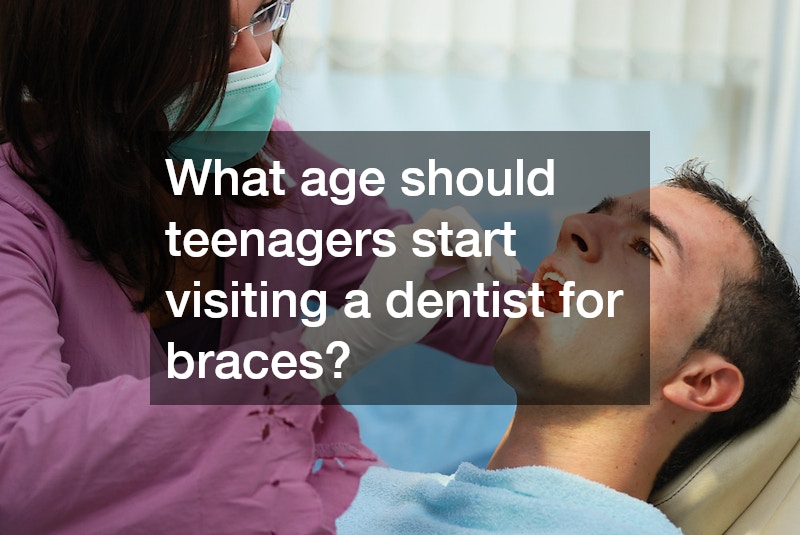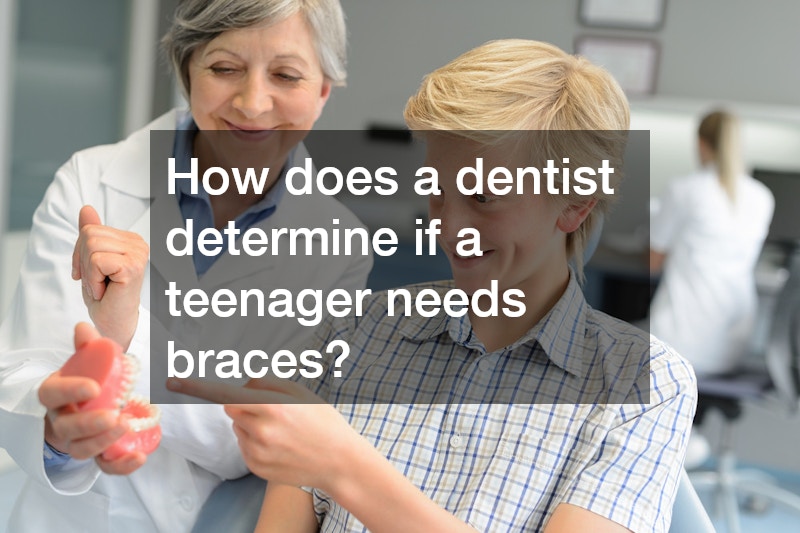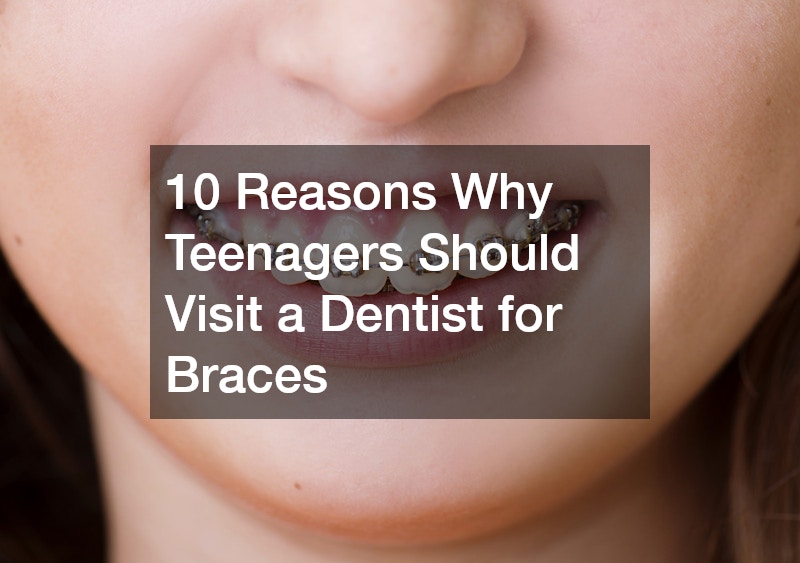This article explores the top reasons why it is beneficial for teenagers to visit a dentist for braces, highlighting both health and cosmetic considerations. Orthodontic care plays a critical role in ensuring the proper development of dental health for teenagers. Understanding the reasons behind the need for such interventions can aid in making informed decisions for the teenager’s long-term oral well-being.
1. What age should teenagers start visiting a dentist for braces?

It’s generally recommended that children begin visiting a family dentist by age 7, which sets the stage for identifying potential orthodontic issues early. By visiting a dentist for teenagers around this age, it’s possible to determine if and when braces might be necessary. This early assessment allows for timely correction, which may prevent more serious dental complications down the line.
A dentist for teenagers can track the growth of a teenager’s teeth and jaw, making it easier to spot misalignments. Early intervention can simplify the process of tooth correction and might reduce the need for more extensive treatment later. Additionally, early visits to the dental office encourage good oral hygiene habits, such as teeth cleaning and regular check-ups.
Although the exact age to start braces varies, many teenagers begin treatment around ages 11 to 14. The timing largely depends on the dentist’s evaluation of the dentist for teenagers and whether their teeth have fully come in. Starting the process early ensures that treatment is completed in a timely manner, promoting a healthy smile by the end of high school.
2. How do braces improve oral health for teenagers?
Braces significantly enhance oral health by correcting misaligned teeth and jaws. A dentist for teenagers can assess common problems such as overcrowding, underbites, and overbites—issues that can lead to long-term dental problems if left untreated. Proper alignment achieved through braces ensures that teeth are easier to clean, reducing the risk of decay and gum disease.
Furthermore, aligning the teeth helps in evenly distributing the stress during chewing, reducing the risk of potential strain on the jaw. This can also lessen the likelihood of developing temporomandibular joint disorders, which might require extensive treatment. Ultimately, braces contribute to better oral function and prevent the need for costly interventions, like a dental implant, in the future.
Teenagers’ regular visits to the dental office for orthodontic treatment encourage consistent teeth cleaning and teeth whitening practices. This not only helps in maintaining oral hygiene during the braces period but also benefits overall dental health beyond the treatment phase. Having a set routine improves the effectiveness of braces and the long-term condition of the teenager’s teeth.
3. Can braces correct common dental issues in teenagers?
Braces are especially effective in correcting a wide range of dental issues frequently encountered by teenagers. A dentist for teenagers can address problems like overlapping or spaced teeth, which are not only cosmetic concerns but can also lead to more serious issues. Correcting these at an adolescent age helps in avoiding complications such as tooth decay and the need for a denture implant at an early age.
Malocclusions, which refer to misalignments between the upper and lower teeth, are also common and correctable through braces. These conditions can complicate chewing and speaking and may result in jaw pain if left untreated. Timely intervention by visiting a dentist for teenagers can ensure these problems are addressed before they worsen.
In some cases, braces can also remedy breathing or sleep issues that result from improper jaw positioning. A comprehensive dental assessment at a dental office enables the dentist to create a customized treatment plan. Such individualized plans foster optimal results and often prevent the need for emergency treatments later on.
4. What options are available for teenagers who need braces?

Today, teenagers have multiple options when it comes to selecting the type of braces they need. Traditional metal braces are still a common choice, valued for their effectiveness in solving a wide variety of dental issues. Nevertheless, advancements in orthodontics have introduced alternatives like ceramic braces and clear aligners, which are more aesthetically pleasing.
The choice of braces depends largely on the specific needs and preferences of the teenager, as well as the advice of the dentist for teenagers. Ceramic braces blend better with the natural tooth color, while clear aligners offer the advantage of being removable. This variety of options ensures that teenagers can find a treatment method that aligns with their lifestyle and cosmetic expectations.
With these alternatives, it’s easier than ever for a dentist to cater to different needs, making orthodontics a less daunting prospect for teenagers. Regardless of the type chosen, regular visits to the dental office remain crucial to adjust and monitor progress. This flexibility fosters a more inclusive orthodontic experience, leading to improved satisfaction and outcomes.
5. How do braces impact a teenager’s confidence and self-esteem?
One significant benefit of braces is their impact on boosting a teenager’s confidence and self-esteem. The prospect of achieving a straight, beautiful smile can motivate teenagers to endure the temporary discomfort associated with braces. When provided by a dentist for teenagers, braces can lead to improved facial aesthetics, fostering a more positive self-image.
The process also encourages personal resilience and adaptability, as wearing braces requires teenagers to adjust to oral hygiene routines and dietary restrictions. Each visit to the dental office becomes a step closer to the desired result, reinforcing a sense of progress and achievement. Furthermore, the support from a skilled family dentist can make teenagers more at ease during the treatment.
Additionally, as teenagers see visual improvements over time, this can translate into improved interactions in social and academic settings. Feeling confident in their smile encourages active participation and engagement, crucial components of teenage development. In turn, these positive experiences can ripple out to other aspects of their life, maintaining the motivation for oral health care post-braces.
6. What is the process of getting braces for teenagers like?
The process of obtaining braces begins with a comprehensive assessment by a dentist for teenagers, who will examine the teeth and take x-rays or impressions to determine the best course of action. After this initial consultation, a customized treatment plan is developed to address specific issues and goals. This plan outlines the type of braces, estimated treatment duration, and any necessary preparatory steps.
Once the plan is agreed upon, the dentist will prepare the teenager’s teeth for the application of braces. This involves cleaning the teeth thoroughly, possibly with a teeth cleaning procedure, to ensure that the adhesive bonds well. The braces are then applied, either through bonding brackets onto the teeth or using aligner trays in the case of clear aligners.
Throughout the treatment period, regular visits to the dental office are necessary for adjustments and evaluations to ensure the treatment is progressing as expected. These appointments provide an opportunity for the dentist to make necessary changes and to address any questions or concerns that might arise. This active monitoring helps achieve optimal results and prevents issues that might require emergency services, like an emergency plumber would in a water damages situation.
7. How long do teenagers typically need to wear braces?

The duration for which teenagers need to wear braces varies, typically ranging from 18 months to 3 years. The exact timeline depends on the complexity of the dental issues being addressed and the type of braces used. Regular consultations with a dentist for teenagers ensure that progress is being tracked and any necessary adjustments are made promptly.
Factors influencing the length of time include the severity of the misalignment, the type of orthodontic appliance used, and the teenager’s adherence to care instructions. In some cases, additional treatments may be necessary, such as dental implants or denture implants, which might extend the treatment timeline. However, maintaining proper oral hygiene and attending scheduled appointments can help optimize treatment and potentially reduce the time braces are needed.
It’s important for teenagers and their parents to understand that patience and commitment during this period contribute to the success of the orthodontic treatment. Trusting the process designed by the dentist for teenagers, coupled with the support of family members, can result in a beautiful, lasting smile. Just like after a water restoration company and their successful intervention, the final results can be worth the wait and effort.
8. Are there specific care instructions for teenagers with braces?
There are several care instructions that teenagers must follow while wearing braces to ensure effective treatment and maintain oral health. Regular brushing and flossing become even more crucial during this period to prevent food particles from becoming trapped in the braces. A dentist for teenagers can provide specific guidance on using special tools like orthodontic brushes or floss threaders to clean around wires and brackets effectively.
It’s also essential to adhere to dietary restrictions to avoid damaging the braces. Chewy, sticky, or hard foods can break brackets and bend wires, prolonging the treatment period. The dental office often provides a list of foods to avoid and tips on adapting food preparation methods to accommodate these changes.
Regular visits to the dental office allow teenagers to address concerns and receive additional care or adjustments as needed. These visits foster continuous progress and help address minor issues before they escalate into emergencies. Just as computer support is critical for maintaining technology, maintaining proper care for braces ensures successful treatment and mitigates potential complications.
9. What role do parents play in a teenager’s orthodontic treatment?
Parents play a vital supporting role in a teenager’s orthodontic treatment, from the initial consultations to the final stages of the process. Being involved in selecting a dentist for teenagers and attending appointments helps parents stay informed and engaged in their child’s progress. Additionally, parents can encourage adherence to care instructions, ensuring that teenagers follow the oral hygiene routines recommended by the dental office.
Financial planning and managing appointments are also critical aspects where parents contribute. Understanding the financial requirements, including payment plans and insurance coverage, can reduce stress and facilitate a smooth treatment process. As teenagers may face initial discomfort or inconvenience, parents can provide emotional support, helping them stay motivated throughout the journey.
Ultimately, by being active participants in their teenager’s dental care, parents help foster a positive attitude towards oral health. This encouragement can lead to long-term benefits, ensuring that good habits and attitudes towards visiting a dentist for teenagers are carried into adulthood. Much like a water restoration company’s role in preventing future damages, parental involvement aids in preventing oral health issues later in life.
10. How does a dentist determine if a teenager needs braces?

Determining whether a teenager needs braces involves a thorough evaluation by a dentist for teenagers, who will examine dental health history, photographs, x-rays, and digital scans. This comprehensive assessment helps the dentist identify any misalignments or issues with the bite that might necessitate orthodontic intervention. Often, an initial check-up hints at potential concerns that warrant further investigation and planning.
The dentist discusses these findings with the teenager and their parents, outlining the potential benefits of braces for the specific conditions identified. At this stage, exploring the different treatment options and the expected duration of the braces helps determine the best course of action. This transparent communication helps teenagers and their families make informed decisions, acknowledging both health and aesthetic considerations.
Ultimately, the decision to proceed with braces rests on the collective input from the family dentist, the teenager’s family, and the dentist for teenagers. Establishing clear expectations provides a foundation for successful treatment and shared satisfaction with the final results. Much like the role of emergency plumbers or computer support experts, a skilled dentist ensures that intervention occurs at the right time for lasting benefits.
Regular dental visits and timely orthodontic evaluations can positively influence a teenager’s oral health and overall well-being. From addressing misalignments to boosting confidence and self-esteem, there are numerous reasons teenagers should consider visiting a dentist for braces. Understanding these top reasons can guide parents and teenagers in making informed decisions about pursuing dental braces, ensuring a healthy and beautiful smile for years to come.
